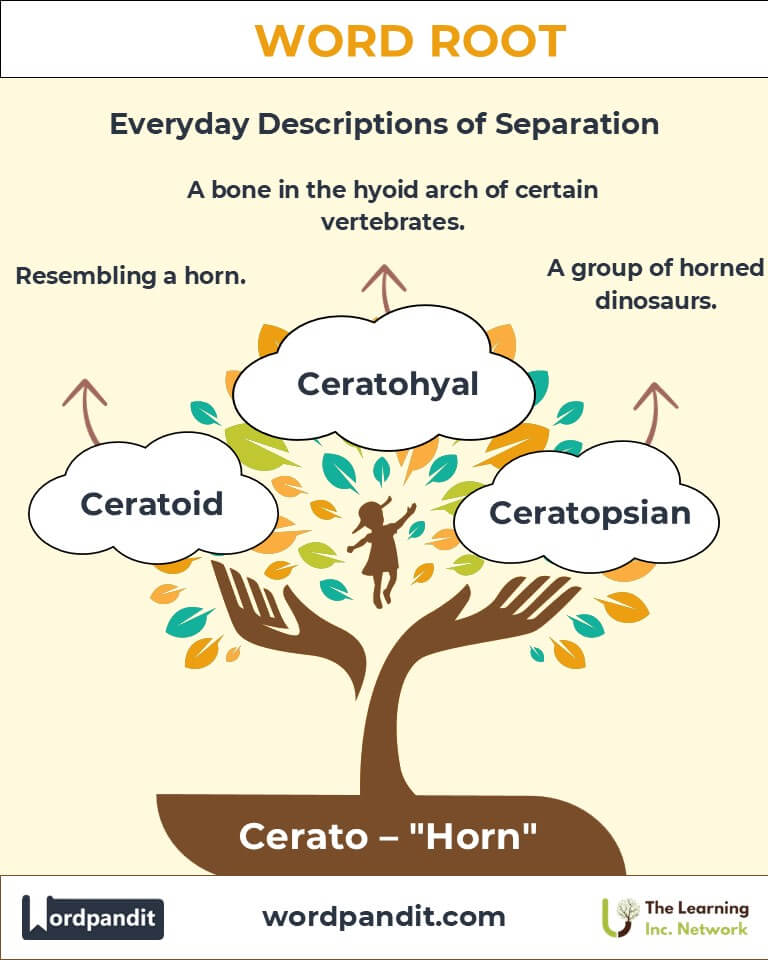Cerato: The Root of Strength and Symbolism in Nature and Culture
Byline: Discover the power and versatility of the root "cerato," derived from the Greek word for "horn." From biological descriptions like "ceratoid" to intriguing behaviors such as "ceratomania," this root emphasizes forms, functions, and fascinations linked to horns.

Table of Contents
- Introduction: The Essence of Cerato
- Etymology and Historical Journey
- Mnemonic: Unlocking the Power of Cerato
- Common Cerato-Related Terms
- Cerato Through Time
- Cerato in Specialized Fields
- Illustrative Story: Cerato in Action
- Cultural Significance of Cerato
- The Cerato Family Tree
- FAQs About the Cerato Word Root
- Test Your Knowledge: Cerato Mastery Quiz
- Conclusion: The Living Legacy of Cerato
1. Introduction: The Essence of Cerato
When we think of horns, images of majestic animals or ornamental designs often come to mind. The word root "cerato" (pronounced sehr-ah-toh) stems from the Greek word keras, meaning "horn." This root plays a vital role in biology, where it describes horn-like structures, and in culture, where horns symbolize strength, power, and even obsession. From ancient artifacts to modern zoology, cerato connects physical forms with symbolic meanings.

2. Etymology and Historical Journey
The root "cerato" originates from the Greek keras (keratos in its genitive form), directly translating to "horn." Early applications of this root are found in classical texts describing horned animals and mythological beings like the Cerastes, a horned serpent. As scientific terminology developed, cerato became integral in anatomical and zoological descriptions, such as ceratopsians (horned dinosaurs). Its usage expanded into psychological and cultural contexts, reflecting humans' fascination with horns.
3. Mnemonic: Unlocking the Power of Cerato
Visualize a mighty ram standing atop a mountain, its large, curved horns gleaming in the sun. The horns, a hallmark of the creature’s identity, symbolize the root "cerato."
4. Common Cerato-Related Terms
- Ceratoid (sehr-ah-toyd): Resembling a horn.
Example: "The ceratoid projections on the sculpture added a rustic, natural aesthetic." - Ceratomania (sehr-ah-toh-may-nee-uh): Obsession with horns or horn-like structures.
Example: "The artist’s ceratomania was evident in his collection of horned animal figurines." - Ceratopsian (sehr-ah-top-see-an): A group of horned dinosaurs.
Example: "The ceratopsian fossils displayed remarkable preservation of their horn structures." - Keratin (keh-rah-tin): A protein forming horn and horn-like structures.
Example: "Rhino horns are composed of tightly packed keratin fibers." - Ceratohyal (sehr-ah-toh-hy-al): A bone in the hyoid arch of certain vertebrates.
Example: "The ceratohyal plays a role in the movement of the tongue in amphibians."
5. Cerato Through Time
- Cerastes (Ancient): A mythical horned snake featured in Greek lore, reflecting early cultural ties between horns and mysticism.
- Ceratopsians (Modern): From fossils unearthed in the 19th century, paleontology illuminated the grandeur of horned dinosaurs like Triceratops.
6. Cerato in Specialized Fields
- Paleontology: Ceratopsians: Horned dinosaurs that reveal evolutionary traits of defense and display.
- Biology: Ceratoid Structures: Horn-like adaptations in animals and plants for protection or mating.
- Psychology: Ceratomania: An emerging study of niche obsessions reflecting personal identity and cultural expression.
- Art and Design: Horn motifs are celebrated in jewelry, furniture, and sculptures, showcasing cerato's aesthetic allure.
7. Illustrative Story: Cerato in Action
In a remote African village, a young artist named Lami found inspiration in the horns of antelopes roaming the savannah. His intricate carvings of ceratoid designs gained international acclaim for their natural beauty. Meanwhile, a paleontologist in Montana discovered a new ceratopsian species, naming it Lamiceras in honor of the artist's work. This cross-disciplinary connection highlighted how the root cerato bridges art and science.
8. Cultural Significance of Cerato
Horns have been revered across cultures as symbols of power, fertility, and spiritual significance. In Greek mythology, Zeus's horned form reflects divine strength, while Viking helmets (though historically inaccurate) evoke martial prowess. The root cerato captures this cultural fascination, resonating through art, literature, and even rituals.

9. The Cerato Family Tree
- Kerato- (horn):
Example: Keratin: Structural protein in horns and skin. - Cornu- (Latin: horn):
Example: Cornucopia: A symbol of abundance shaped like a horn. - Rhino- (nose or horn):
Example: Rhinoceros: "Nose horn" in Greek.
10.FAQs About the Cerato Word Root
Q1: What does "cerato" mean?
A: The root "cerato" comes from the Greek word keras, meaning "horn." It is often used to describe horn-like structures in biology and zoology, emphasizing the physical resemblance to horns in shape or composition.
Q2: How is "cerato" applied in scientific contexts?
A: "Cerato" is commonly used in fields like paleontology, anatomy, and zoology. For example:
- Ceratopsians: A group of horned dinosaurs, such as Triceratops.
- Ceratoid structures: Features resembling horns found in plants or animals.
- Ceratohyal bone: A part of the hyoid apparatus in some vertebrates.
Q3: What is ceratomania?
A: Ceratomania refers to an intense fascination or obsession with horns or horn-like objects. It can be a psychological fixation or an artistic fascination, influencing cultural artifacts and creative designs.
Q4: What are horns made of? Are they always the same material?
A: Animal horns are primarily made of keratin, the same protein found in human nails and hair. However, antlers are made of bone and not keratin. Horn structures in plants or art are often modeled after the shape rather than composition.
Q5: What are examples of cultural symbols involving horns?
A: Horns have diverse symbolic meanings:
- Strength and power: Horns on gods like Zeus or Norse helmets symbolize might.
- Fertility: Horns are tied to abundance and vitality in agricultural societies.
- Divinity: The cornucopia (horn of plenty) represents prosperity and generosity.
Q6: What is the connection between "cerato" and dinosaurs?
A: Many horned dinosaurs belong to the group Ceratopsians. The name comes from the root "cerato," referring to their prominent facial horns and frills used for defense and mating displays.
Q7: How do horns function in animals?
A: Horns serve various purposes in animals, such as:
- Defense: Protecting against predators.
- Mating rituals: Horn size or shape may attract mates or establish dominance.
- Temperature regulation: In some species, horns help dissipate heat.
11.Test Your Knowledge: Cerato Word Root Quiz
1. What does the root "cerato" signify?
2. Which term refers to horned dinosaurs?
3. What is ceratomania?
4. What is the protein found in horns?
5. Which cultural symbol uses a horn to represent abundance?

12. Conclusion: The Living Legacy of Cerato
The root cerato elegantly unites the physical and symbolic aspects of horns. From dinosaurs to divine symbols, its influence spans science, art, and culture. As humanity continues to study and celebrate the natural world, the legacy of cerato endures, reminding us of the enduring power and beauty of this ancient form.











